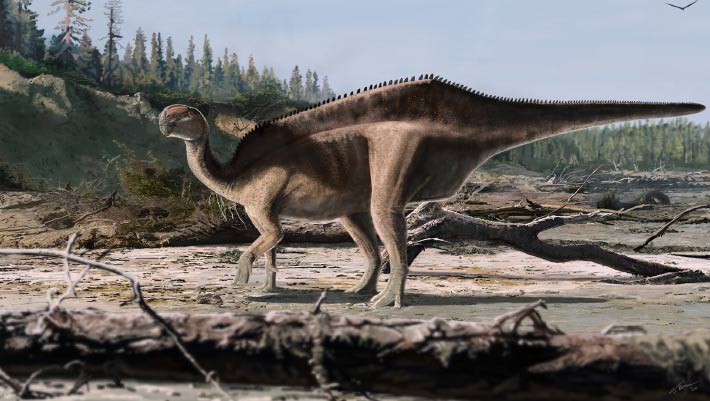A new genus and species of sail-backed iguanodontian dinosaur has been identified from a partial skeleton found in the Wessex Formation of the Isle of Wight, England.
Life restoration of Istiorachis macarthurae. Image credit: James Brown.
Scientifically named Istiorachis macarthurae, the new dinosaur species lived in what is now England during the Early Cretaceous epoch, some 125 million years ago.
The ancient animal was a member of a large and biogeographically widespread group of herbivorous dinosaurs called Iguanodontia.
“Iguanodontia was a highly successful clade of ornithischian dinosaurs, the earliest known example being the dryosaurid Callovosaurus leedsi from the Middle Jurassic Oxford Clay Formation of England,” said Jeremy Lockwood, a paleontologist at the University of Portsmouth and the Natural History Museum, London, and his colleagues.
“By the end of the Cretaceous, they dominated the dinosaur fauna of Laurasia as the duck-billed hadrosaurids, a group containing well-known species such as Edmontosaurus regalis and Parasaurolophus walker.”
“Iguanodontian diversity was low in the Late Jurassic but increased throughout the Early Cretaceous.”
Istiorachis macarthurae’s most striking feature is a series of extremely elongated spines along its back and tail, which probably supported a large, sail-like structure.
“Evolution sometimes seems to favor the extravagant over the practical,” Lockwood said.
“While the exact purpose of such features has long been debated — with theories ranging from body heat regulation to fat storage — researchers believe that the most likely explanation in this case is visual signaling, possibly as part of a sexual display and this usually is because of sexual selection.”
“In modern reptiles, sail structures often show up more prominently in males, suggesting that these attributes evolved to impress mates or intimidate rivals.”
“We think Istiorachis macarthurae may have been doing much the same.”
To work out what the sail might have been for, the paleontologists carried out a close examination of the fossilized bones.
They then created a large database of similar dinosaur back bones from direct observations, photos, scientific illustrations and reconstructions, and used it to trace the evolutionary history of the heights of back bones on a new family tree of iguanodontian dinosaurs.
This allowed them to spot broader trends in how these sails evolved.
“These methods let us move beyond simply describing the fossil and actually test hypotheses about its function,” Lockwood said.
“We showed that Istiorachis macarthurae’s spines weren’t just tall — they were more exaggerated than is usual in Iguanodon-like dinosaurs, which is exactly the kind of trait you’d expect to evolve through sexual selection.”
Istiorachis macarthurae appears to highlight a broader evolutionary trend.
Research shows that elongation of neural spines in iguanodontians began in the Late Jurassic, before becoming a relatively common feature during the Early Cretaceous.
However, true hyper-elongation, where spines stretch to more than four times the height of the vertebral body, remains rare.
Similar displays are seen in living reptiles today, including several species of lizard, where elaborate crests and sails typically signal health and strength to potential mates.
“Istiorachis macarthurae is a deep-time example of the same evolutionary pressures we see shaping display structures in modern animals,” Lockwood said.
The findings were published this week in the journal Papers in Palaeontology.
_____
Jeremy A.F. Lockwood et al. 2025. The origins of neural spine elongation in iguanodontian dinosaurs and the osteology of a new sail-back styracosternan (Dinosauria, Ornithischia) from the Lower Cretaceous Wealden Group of England. Papers in Palaeontology 11 (4): e70034; doi: 10.1002/spp2.70034
